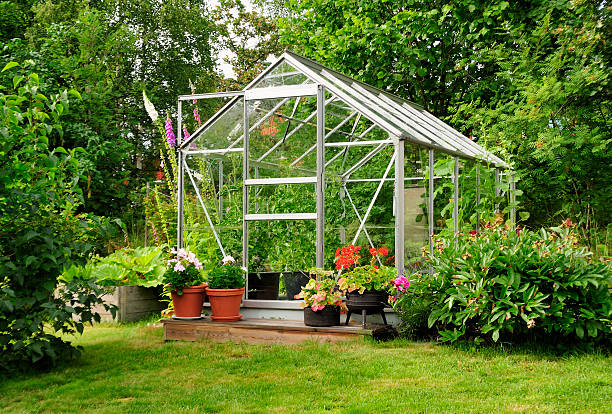Old plant residues transform themselves into fresh fertilizer and soil conditioner – this is what happens in the marvelous compost heap. We would like to explain why everyone with a garden should have a compost.
How do I create a compost?
In six steps to the perfect compost

1. Choose a place that is as sheltered as possible
Because a compost heap should neither be dried out by strong sunlight nor overly soaked by heavy rain, a place under a tree is a good idea, which can be a little apart, as a compost heap is usually not one of the visual highlights in the garden.
2. Decide on a shape
It doesn’t matter whether you use an open pile, for which you need a lot of “raw materials”, or whether you use a form or a frame made of wood or metal, since good results can be expected in all variants. Thermocomposters have the advantage that the heat is retained well inside, which speeds up the rotting process.
3. Do not create a base plate
However, it is important that the compost lies directly on the ground and not on stone slabs, for example, since useful rotting helpers such as earthworms can migrate on their own. In addition, excess moisture can drain off better.
4. Layer loosely
The material should be loosely stacked so that there is sufficient oxygen. So don’t compress your compost. Also, do not put too thick layers of one material on the heap, as this can result in disadvantages depending on the material. A layer of autumn leaves that is too thick can be too dry and lacking in nutrients, while a layer of grass clippings that is too thick tends to rot. So mix up the materials.
5. Switch every 3 months
To ensure good rotting, you can move your compost after about 3 months: shovel your pile to a spot next to it. This mixes and aerates all the layers again, so that the pile can mature well. In the case of prefabricated compost bins, 2 or 3 components are therefore often offered together for implementation.
6. Cover or water as needed
The compost should be moist but not wet at all times. You can therefore cover it with mulch fleece, for example, so that both dehydration and excessive moisture after rainfall are avoided. In very dry phases, it makes sense to water your compost.
What goes in the compost?
Too good for the bin
If plant residues or certain kitchen waste are disposed of with the residual waste, valuable substances from the natural cycle are lost. To prevent this from happening, you can either dispose of them in the organic bin – the contents of which are composted professionally and on a large scale – or even better on your own compost. But what exactly can go on the compost?
Valuable raw materials for a compost are:
Plant residues from the garden, including flowers and ornamental plants
lawn clippings
leaves
leftover fruit and vegetables
coffee grounds
Crushed egg shells
Teabag
In small quantities cardboard, kitchen paper and newspaper
Not to be composted or only to a limited extent are:
Plants with soil-borne diseases such as clubroot or sclerotinia or with late blight should be discarded with household waste because the diseases survive composting and are then spread throughout the garden, while composting of plants affected by powdery mildew is unproblematic.
Weeds should not have flowered yet because the seeds can survive composting. Some garden operations therefore have their own weed compost heaps, which remain in place much longer so that the seeds are also decomposed. Root weeds such as goutweed or couch grass should be allowed to dry out well before being put on the compost.
Wood in a compact form, i.e. a thick branch, is problematic on the compost heap because it rots very slowly and blocks the energy of many microorganisms. However, if a compost pile is too damp, a layer of shrub cuttings or chopped branches can provide better aeration.
Citrus fruit peels also rot very slowly and are therefore unsuitable for compost.
Cooked or animal leftovers, baked goods, fat and oil are also not intended for the compost heap as they attract rats.
Ash is not suitable either, as it is often contaminated with heavy metals.
Why compost?
Bacteria, protozoa, fungi and other microorganisms, but also worms, isopods and springtails are responsible for a fascinating process that turns kitchen waste, plant remains, grass clippings, leaves and other things into a particularly valuable and nutrient-rich substrate – the compost. Compost enhances any soil: it enriches sandy soil with structure and nutrients, loamy and clayey soil becomes looser and easier to work with by continuously adding compost. In addition, the humus content in the soil is increased, soil life is stimulated and, depending on the degree of maturity of the compost, the soil is also fertilized. So no garden should have to do without compost.
What happens in the compost heap?
Rotting in the compost begins when the microorganisms first break down proteins and sugars. Organisms such as bacteria and fungi multiply rapidly, and the temperature in the compost also rises. After about 2 weeks, the temperature in the compost heap can rise to 60 degrees, so that heat-loving fungi take over further implementation. However, this so-called hot rotting is not achieved in most compost heaps in the hobby sector because the heaps are too small for this and material is usually thrown onto the compost heap one after the other. After about 3 months, the temperature drops back to about 40 degrees and the so-called main rotting begins. The compost heap can now be moved. Substances that are difficult to decompose are then mineralized during post-rotting.
You can get these types of compost
Compost is not just compost
Depending on when you remove the compost, you will get different degrees of maturity of the compost, which accordingly have different properties.
Fresh compost
But fresh compost, which you can remove after about 3 months and in which some of the raw materials can still be identified, can also play an important role in the vegetable garden. Since this contains significantly more nutrients than the mature version, you can use this as a mulch for your heavy feeders or berry bushes, as you have an excellent fertilizer with it.
Mature compost
At the end of the rotting process you get classic mature compost. Depending on the starting materials, this can be the case after 6-12 months. It is dark, finely crumbly and smells pleasantly of forest soil. You can now apply about 3 liters of this to one square meter of vegetable patch. To do this, rake it in evenly and superficially. Since immature compost can be harmful to seedlings, you can simply sow some watercress on a 1:1 mix of garden soil and your compost. If it germinates and grows without any problems, the compost is ripe.
Compost soil

If you wait longer, the mature compost will become compost soil. The organic content of the compost breaks down again over time, so that there is hardly any fertilizing effect. However, compost is still excellent as a soil improver.








